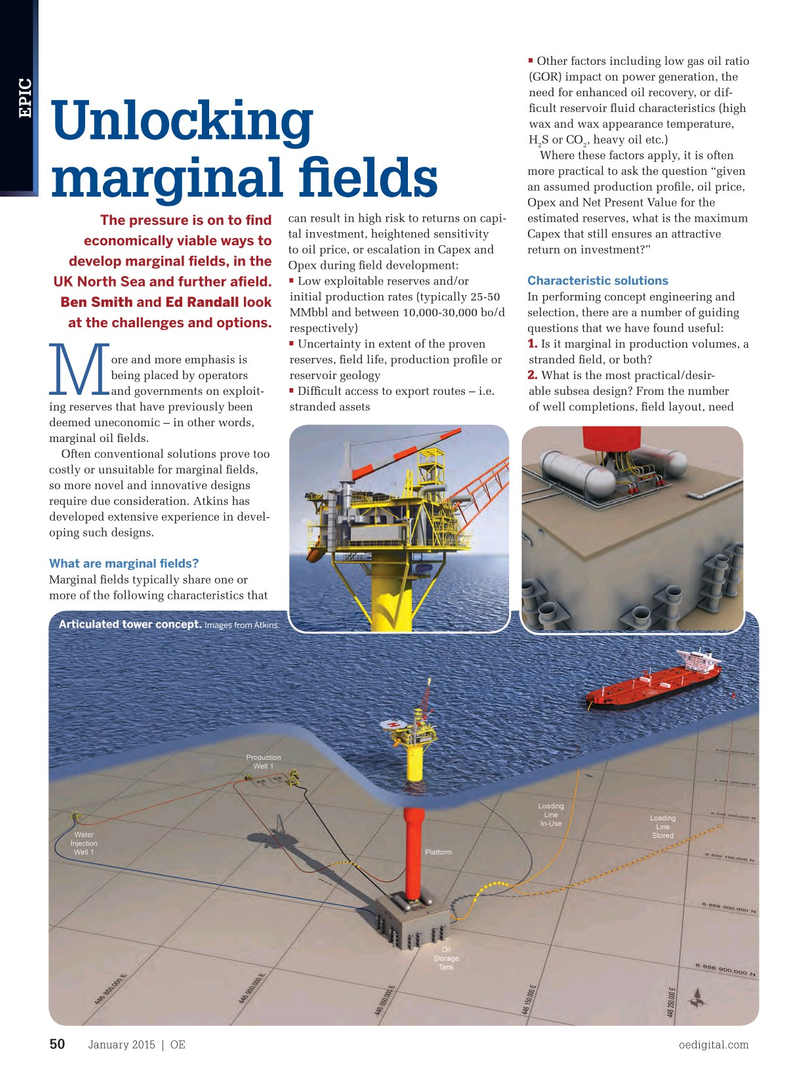
Page 48: of Offshore Engineer Magazine (Jan/Feb 2015)
Read this page in Pdf, Flash or Html5 edition of Jan/Feb 2015 Offshore Engineer Magazine
Other factors including low gas oil ratio for through • (GOR) impact on power generation, the life drilling or need for enhanced oil recovery, or dif- well interven- fcult reservoir fuid characteristics (high tion, dry or wet
EPIC wax and wax appearance temperature, trees?
Unlocking 3.
H S or CO , heavy oil etc.) Is the feld 2 2
Where these factors apply, it is often short-lived? Do more practical to ask the question “given we need a re- an assumed production profle, oil price, usable solution?
marginal felds 4.
Opex and Net Present Value for the What are estimated reserves, what is the maximum can result in high risk to returns on capi- the limiting
The pressure is on to fnd
Capex that still ensures an attractive tal investment, heightened sensitivity factors in water economically viable ways to return on investment?” to oil price, or escalation in Capex and depth, met- develop marginal felds, in the
Opex during feld development: ocean and other
Low exploitable reserves and/or environmental • Characteristic solutions
UK North Sea and further afeld.
In performing concept engineering and initial production rates (typically 25-50 parameters?
Ben Smith and Ed Randall look 5. selection, there are a number of guiding MMbbl and between 10,000-30,000 bo/d Can we also at the challenges and options.
questions that we have found useful: respectively) drive toward • 1.
Is it marginal in production volumes, a Uncertainty in extent of the proven an inherent stranded feld, or both? reserves, feld life, production profle or ore and more emphasis is level of safety
What is the most practical/desir- reservoir geology being placed by operators – de-manning 2.
M • able subsea design? From the number Diffcult access to export routes – i.e. and governments on exploit- and automated of well completions, feld layout, need stranded assets ing reserves that have previously been operation, deemed uneconomic – in other words, maintenance marginal oil felds. and intervention to reduce Opex?
Often conventional solutions prove too On the UK Continental Shelf (UKCS) costly or unsuitable for marginal felds, alone there are a number of innovative so more novel and innovative designs options specifcally designed for small require due consideration. Atkins has felds that attempt to answer these ques- developed extensive experience in devel- tions. These include operating assets, oping such designs. such as the Sevan 300s, operating on the
Chestnut and Huntingdon felds, and
What are marginal felds?
those in planning including Arup’s ACE
Marginal felds typically share one or Platform, destined for the Bentley oil more of the following characteristics that feld, and a range of production buoys
OE ( : May 2014).
Articulated tower concept. Images from Atkins.
The following examples demonstrate how some of the above questions have been answered across a number of projects carried out in Atkins. A key theme running through these examples is that of combining a relatively old idea – oil-over-water storage – with mod- ern approaches to managing safety and potential environmental impact.
Stranded felds and subsea tanks
For remote felds where the reserves cannot justify the cost of installing a pipeline, subsea tanks are often a viable alternative to a foating storage and offoading unit. The technology is mature with multiple examples where it has been successfully employed. In a previ- ous study for a UKCS marginal feld, by careful iteration between process and structural design, Atkins devised a low- weight facility that minimized overall
Capex by combining a subsea tank and an articulated tower to support a normally unmanned installation.
The compliant tower is tuned to avoid
January 2015 | OE oedigital.com 50 050_OE0115_EPIC2_Adkins.indd 50 12/22/14 6:46 PM

 47
47

 49
49